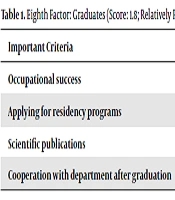Dear editor,
Internal assessment is an inherent element of every educational system. Assessment of educational programs could determine the extent to which educational goals are achieved, and the shortcomings of the educational programs could also be detected and corrected as such. As a result, the quality of educational programs could be improved profoundly (1, 2).
The School of Dentistry of Kermanshah University of Medical Sciences (KUMS), in Iran started its activity less than a decade ago. The faculty members of the School of Dentistry are relatively young and may have shortcomings due to inexperience. To the best of our knowledge, a comprehensive assessment of the performance of the faculty members and students of this university has not been conducted so far. Considering the significance of the information on this subject to improve the quality and quantity of the output of the university, the present study aimed to perform a comprehensive assessment of the performance of the Orthodontics Department of the School of Dentistry of KUMS, including the head of the department, faculty members, technicians, students, and graduates, in 2018.
Initially, the faculty members were informed on the study and the significance of internal assessment and its process. Since internal assessment should be based on the set targets of the department, an internal assessment committee was first recruited to determine and write down the goals and notions of the department. For this purpose, the general goals of the educational programs, tasks of the department, and the major and minor goals were specified. At the next stage, the internal assessment factors, criteria, and indicators were determined. Finally, the designed questionnaires were approved by the head of the department and the assessment committee, and their optimal validity was confirmed based on eight parameters, which were evaluated based on 153 criteria and 453 indicators. Each indicator was scored based on a three-point Likert scale as unfavorable (score zero), relatively favorable (score one), and favorable (score two).
The questionnaires were distributed among the participants. They were initially provided with some information regarding the questions and the reasons for this evaluation and were assured of the confidentiality of their information. A checklist was used to assess educational equipment, facilities, and human resources. Table 1 shows the obtained results regarding the favorability level of each factor, as well as its criteria and indicators.
| Important Criteria | Score of Each Criterion | Suggestions |
|---|---|---|
| Occupational success | Favorable (2.6) | - Providing conditions to admit postgraduate students |
| Applying for residency programs | Relatively favorable (1.8) | - Holding meetings and inviting graduates to university to enable interactions between them, current dental students, and faculty members |
| Scientific publications | Unfavorable (1.5) | |
| Cooperation with department after graduation | Unfavorable (1.3) |
Eighth Factor: Graduates (Score: 1.8; Relatively Favorable)
Based on the findings, the following suggestions are proposed to help eliminate the weaknesses and further improve the strengths of this department:
1- Goals and notions should be revised, and recruiting post-graduate students should be defined as a goal of this department.
2- Proper programs should be designed to improve the activities and cooperation of students and faculty members in the department.
3- Considering the relatively young faculty members of the department, it seems that the scientific and academic ranking of the faculty members would improve over time.
4- The cooperation of the faculty members in the research projects of other organizations should be promoted.
5- Facilities should match the number of the admitted students.
6- It is recommended that the faculty members participate in courses of novel educational techniques to enhance the quality of education.
7- Communication with the graduates should be improved by holding annual meetings and inviting them to participate in research activities with the faculty members.
In general, the overall quality of the performance of the Orthodontics Department of KUMS in 2018 was relatively favorable. 'Educational programs' and 'faculty members' were the most favorable factors, while 'equipment, facilities, and human resources' and 'learning strategies' were the least favorable factors in this regard, which require special attention.
